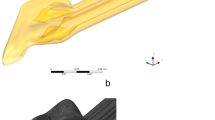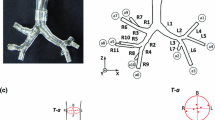Abstract
The nasal cavity is the main passage for air flow between the ambient atmosphere and the lungs. A preliminary requisite for any investigation of the mechanisms of each of its main physiological functions, such as filtration, air-conditioning and olfaction, is a basic knowledge of the air-flow pattern in this cavity. However, its complex three-dimensional structure and inaccessibility has traditionally prevented a detailed examination of internalin vivo orin vitro airflow patterns. To gain more insight into the flow pattern in inaccessible regions of the nasal cavity we have conducted a mathematical simulation of asymmetric airflow patterns through the nose. Development of a nose-like model, which resembles the complex structure of the nasal cavity, has allowed for a detailed analysis of various boundary conditions and structural parameters. The coronal and sagittal cross-sections of the cavity were modeled as trapezoids. The inferior and middle turbinates were represented by curved plates that emerge from the lateral walls. The airflow was considered to be incompressible, steady and laminar. Numerical computations show that the main air flux is along the cavity floor, while the turbinate structures direct the flow in an anterior-posterior direction. The presence of the turbinates and the trapezoidal shape of the cavity force more air flux towards the olfactory organs at the top of the cavity.
Similar content being viewed by others
References
Brash, J. P. (1951)Cunningham's text book of anatomy. Medical Publ., Oxford, UK.
Cole, P., Chaban, R., Naito, K. andOprysk, D. (1988) The obstructive nasal septum.Arch. Otolaryngol. Head & Neck Surg.,114, 410–412.
Douek, E. (1974)The sense of smell and its abnormalities. Churchill Livingstone, London, UK.
Girardin, M., Bilgen, E. andArbour, P. (1983) Experimental study of velocity fields in a human nasal fossa by laser anemometry.Ann. Otol. Rhinol. Laryngol.,92, 231–236.
Lang, J. (1989)Clinical anatomy of the nose, nasal cavity and paranasal sinuses. Thiem Medical Publ., New York, USA.
Morgan, K. T. andMonticello, T. M. (1990) Airflow, gas deposition, and lesion distribution in the nasal passages.Environ. Health Persp.,88, 209–218.
Mygind, N. (1979)Nasal allergy. Blackwell Science Publ., Oxford, UK.
Patra, A. L., Gooya, A. andMorgan, K. T. (1986) Airflow characteristics in a baboon nasal passage cast.J. Appl. Physiol.,61, 1959–1966.
Proctor, D. F. (1966) Airborne disease and the upper respiratory tract.Bacteriol. Rev.,30, 498–513.
Proctor, D. F. andAndersen, I. (1982)The nose, upper airway physiology and the atmospheric environment. Elsevier Biomedical Press, Amsterdam, The Netherlands.
Proetz, A. W. (1951) Air currents in the upper respiratory tract and their clinical importance.Ann. Otol. Rhinol. Laryngol.,60, 439–467.
Scherer, P. W., Hahn, I. I. andMozell, M. M. (1989) The biophysics of nasal airflow.Otolaryngol. Clin. N. Am.,22, 265–278.
Swift, D. L. andProctor, D. F. (1977) Access of air to the respiratory tract. InRespiratory defense mechanisms.Brain, J. D., Proctor, D. F. andReid, L. M. (Eds.), Marcel Dekker Inc., New York, USA.
Vander, A. J., Shermann, J. H. andLuciano, D. S. (1975)Human physiology: the mechanisms of body function. McGraw Hill Co., New York, USA.
Author information
Authors and Affiliations
Rights and permissions
About this article
Cite this article
Elad, D., Liebenthal, R., Wenig, B.L. et al. Analysis of air flow patterns in the human nose. Med. Biol. Eng. Comput. 31, 585–592 (1993). https://doi.org/10.1007/BF02441806
Received:
Accepted:
Issue Date:
DOI: https://doi.org/10.1007/BF02441806




